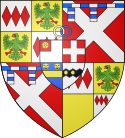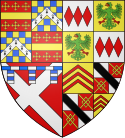Zweite Schlacht von St Albans
| Zweite Schlacht von St Albans | |||||||||||||||||
|---|---|---|---|---|---|---|---|---|---|---|---|---|---|---|---|---|---|
| Teil von: Rosenkriege | |||||||||||||||||
| Datum | 17. Februar 1461 | ||||||||||||||||
| Ort | St Albans, Hertfordshire | ||||||||||||||||
| Ausgang | Sieg des Hauses Lancaster | ||||||||||||||||
| |||||||||||||||||
St Albans – Blore Heath – Ludlow – Northampton – Wakefield – Mortimer’s Cross – St Albans – Ferrybridge – Towton – Hedgeley Moor – Hexham – Edgecote Moor – Losecote Field – Barnet – Tewkesbury – Bosworth Field – Stoke
Die Zweite Schlacht von St Albans war eine Schlacht im Rahmen der Rosenkriege und wurde am 17. Februar 1461 in der Nähe der Stadt St Albans ausgetragen. Die Schlacht endete mit einem Sieg des Hauses Lancaster und der Befreiung Königs Heinrich VI. aus den Händen des Hauses York.
Hintergrund und Ablauf der Schlacht
Richard Plantagenet, 3. Duke of York, war im Dezember 1460 in der Schlacht von Wakefield geschlagen und getötet worden, und sein achtzehnjähriger Sohn, Eduard of March (der spätere König Eduard IV.) war im Westen beschäftigt, wo zwanzig Tage vorher die Schlacht von Mortimer’s Cross stattgefunden hatte. So war der Weg für die Lancastrianer frei, welche von Königin Margarete von Anjou nach Süden in Richtung London geführt wurden.
Die Lancastrianer wurden nahe St Albans von einer von Richard Neville, 16. Earl of Warwick geführten Armee der Yorkisten aufgehalten. Warwick ließ seine Männer einen Verteidigungsring mit Gräben und Spießen aufbauen, wurde jedoch davon überrascht, dass die Lancastrianer aus einer anderen Richtung kamen – statt von Luton von Dunstable aus – und wurde geschlagen.
Die Lancastrianer erlangten dabei König Heinrich VI., den Ehemann Margaretes von Anjou, aus Yorkscher Gefangenschaft zurück, der während der Schlacht singend unter einem Baum gesessen hatte, doch nutzten sie nicht die Gelegenheit, weiter nach London zu marschieren. Die Gründe sind nicht klar; vielleicht war ihnen ihr Ruf als Plünderer vorausgeeilt, und das hätte die Londoner veranlasst, die Tore geschlossen zu halten.
Literatur
- John A. Wagner: Encyclopedia of the Wars of the Roses. ABC Clio, 2001, ISBN 1-85109-358-3, S. 242.
- Philip A. Haigh: The Military Campaigns of the Wars of the Roses. Sutton Publishing, Stroud 1995, ISBN 0-7509-1430-0.
- Alison Weir: Lancaster and York. The Wars of the Roses. Jonathan Cape, London 1995, ISBN 0-224-03834-6.
Koordinaten: 51° 45′ 18″ N, 0° 20′ 10″ W
Auf dieser Seite verwendete Medien
Autor/Urheber: Grünen, Lizenz: CC BY-SA 4.0
Coat of arms of Sir Andrew Trollope, Master Porter of Calais, soldier of the Wars of the Roses (XVth century)
Autor/Urheber: Sodacan, Lizenz: CC BY-SA 3.0
Arms of Margaret of Anjou. Blason: Parti per pale. Dexter: grand parti per pale, grand dexter: France moderne (for Henry VI as claimant to the throne of France); grand sinister: quarterly 1 and 4 - France moderne, 2 and 3 - England (for Henry VI of England). Sinister: grand parti of six (three over three), i. Barry of eight Argent and Gules (for the Kingdom of Hungary); ii. Azure seme-de-lys Or a label of three points Gules (France ancient a label of three points Gules) (for the Angevin Kingdom of Naples); iii. Argent a cross potent Or cantoned by four crosslets Or (for the Latin Kingdom of Jerusalem); iv. Azure seme-de-lys Or a bordure Gules (France ancient a bordure Gules) (for the County of Anjou); v. Azure crusily fitchy two barbels addorsed Or (for the Duchy of Bar) note: the barbels should be addorsed (dorsal fins toward center); vi. Or a bend Gules three alerions Argent (for the Duchy of Lorraine).
Text from: The Heraldry of Queens’ College, Cambridge By David Broomfield BA (Hons)[1]
The curious agglomeration of quarterings in Margaret’s arms can be traced back to the first House of Anjou. Charles Count of Anjou and Maine (d.1285) was the youngest son of Louis VIII King of France. He conquered the Hohenstaufens and made himself King of Naples and Sicily, he also purchased a claim to the, by then fictional, Kingdom of Jerusalem. King Charles’s arms were those of Anjou (Ancient), France differenced by a red label, and Jerusalem. Charles’s son, Charles II King of Naples married Mary daughter of Stephen V and sister of Ladislaus IV Kings of Hungary. Their eldest son, Charles “Martel”, founded his own line of Kings of Hungary that died out in 1382. Charles and Mary’s daughter Margaret married Charles Count of Valois the son of Philip III King of France. Charles of Naples granted to Charles of Valois the Counties of Anjou and Maine. When Joanna Queen of Naples died she bequeathed the kingdom of Naples to Louis Duke of Anjou. Louis was the great grandson of Margaret of Anjou and Charles of Valois. This the second House of Anjou used the arms of France differenced by a red border, giving us Anjou (Modern). Rene, grandson of Louis I, was Duke of Anjou and Titular King of Naples and Jerusalem and by virtue of his marriage to Isabel of Lorraine he was also Duke of Lorraine and Bar. Queen Margaret was Rene’s daughter. Her arms can be delineated thus: HUNGARY: Barry of eight gules and argent. Though contrary to English heraldry this is how the arms of Hungary were and are shown, the four white bars symbolising the rivers of Hungary. Margaret was descended from Mary sister and heiress of Ladislaus the last King of Hungary of the House of Arpad. Margaret’s father Rene of Anjou, Kings of Naples, always used Barry of eight argent and gules as can be seen from many sources. However, I doubt he ever visited Hungary and his connection with that country was remote but his daughter no doubt took her lead from him when it came to the display of her personal heraldry and passed this on to her College. ANJOU (ANCIENT): Azure semy of fleur de lis or a label of three points gules. These were the arms of the first House of Anjou and borne by Charles d.1285, Count of Anjou, conqueror of Naples and claimant to the throne of Jerusalem. Unfortunately in the painting of the arms in the grant the label is wrongly shown as silver a mistake much repeated about the College. These arms became synonymous with the kingdom of Naples. JERUSALEM: Argent a cross potent between four crosses humetty or. The unique nature of Jerusalem was signified by breaking the cardinal rule of heraldry by placing one metal (gold) on another metal (silver). The cross potent (having flat bars at the ends of the arms) was said to symbolise the letters H and I from “Hierusalem”. Again Cooke’s grant depicts the small crosses between the arms as “potent” while not technically wrong and indeed depicted this way in some Medieval books of arms small plain crosses fit the space better. ANJOU (MODERN): Azure semy of fleur de lis or a border gules. The arms as borne by the second House of Anjou begun by Charles of Valois, Count of Anjou the progenitor of the House of Valois and Naples. BAR: Azure semy of cross crosslets fitchy two barbels hauriant and addorsed. The barbels are clearly punning (or canting) references to Bar. The fish have their heads pointing upwards (as opposed to urinant when their heads are at the bottom of the shield) and addorsed means back to back. The crosses should have a point for the lower arms, some versions at Queens’ have it the same as the other arms. The other usual error is to have a specific number of crosses. “Semy” means that the field is spread with charges and they overlap the edges. Cooke also blazons them as “luces”. In the quarterings used by Rene of Anjou the barbels always grip a cross crosslet fitchy in their mouths. This is well attested in contemporary versions of his arms. In Queens’ they appear thus only once, in the stained glass shield of Queen Margaret’s arms in the Old Senior Combination Room making it likely that these date from the 15th Century. LORRAINE: Or on a bend gules three alerions displayed argent. Alerions are eagles that have neither beaks nor claws. They are best shown with a hole in the middle of the head. It was said that Godfrey of Bouillon (or another) fired an arrow that brought down three birds simultaneously. It is also said that “Alerion” is an anagram of “Lor(r)aine”. In mythology it was said that only two birds existed at any time, they laid a pair of eggs every sixty years and they drowned themselves after hatching. To add to the confusion Cooke describes them as “eagles” and they appear as eagles many times in the
College.Autor/Urheber: Sodacan, Lizenz: CC BY-SA 3.0
Arms of Thomas of Brotherton, 1st Earl of Norfolk
Autor/Urheber: unknown, Lizenz: CC BY-SA 4.0
Autor/Urheber: Ipankonin, Lizenz: CC BY-SA 3.0
Coat of arms of Warwick the Kingmaker.









